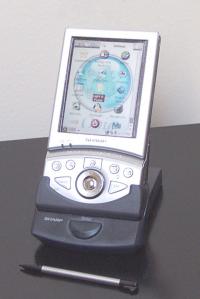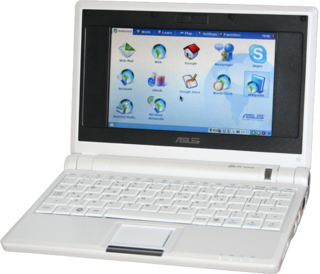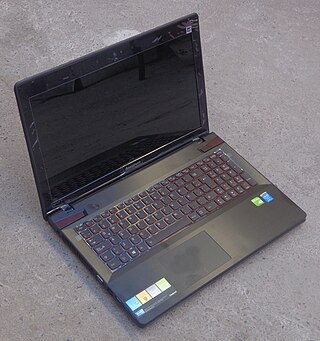Related Research Articles

Windows 95 is a consumer-oriented operating system developed by Microsoft as part of its Windows 9x family of operating systems. The first operating system in the 9x family, it is the successor to Windows 3.1x, and was released to manufacturing on July 14, 1995, and generally to retail on August 24, 1995, almost three months after the release of Windows NT 3.51. Windows 95 is the first version of Microsoft Windows to include taskbar, start button, and accessing the internet. Windows 95 merged Microsoft's formerly separate MS-DOS and Microsoft Windows products, and featured significant improvements over its predecessor, most notably in the graphical user interface (GUI) and in its simplified "plug-and-play" features. There were also major changes made to the core components of the operating system, such as moving from a mainly cooperatively multitasked 16-bit architecture to a 32-bit preemptive multitasking architecture, at least when running only 32-bit protected mode applications.
VAIO is a brand of personal computers and consumer electronics, currently developed by Japanese manufacturer VAIO Corporation, headquartered in Azumino, Nagano Prefecture.

The Sharp Zaurus is the name of a series of personal digital assistants (PDAs) made by Sharp Corporation. The Zaurus was the most popular PDA during the 1990s in Japan and was based on a proprietary operating system. The first Sharp PDA to use the Linux operating system was the SL-5000D, running the Qtopia-based Embedix Plus. The Linux Documentation Project considers the Zaurus series to be "true Linux PDAs" because their manufacturers install Linux-based operating systems on them by default. The name derives from the common suffix applied to the names of dinosaurs.

The PowerBook G3 is a series of laptop Macintosh personal computers designed, manufactured, and sold by Apple Computer from 1997 to 2001. It was the first laptop to use the PowerPC G3 (PPC740/750) series of microprocessors, and was marketed as the fastest laptop in the world for its entire production run. The PowerBook G3 was succeeded by the PowerBook G4.

The iMac G4 is an all-in-one personal computer designed, manufactured, and sold by Apple Computer from January 2002 to August 2004. It was announced at Macworld San Francisco in January of 2002. It replaced the iMac G3 and was succeeded by the iMac G5.
A thin-film-transistor liquid-crystal display is a variant of a liquid-crystal display that uses thin-film-transistor technology to improve image qualities such as addressability and contrast. A TFT LCD is an active matrix LCD, in contrast to passive matrix LCDs or simple, direct-driven LCDs with a few segments.

ZEN is a series of discontinued portable media players designed and manufactured by Creative Technology Limited. The players evolved from the NOMAD brand through the NOMAD Jukebox series of music players, with the first separate "ZEN" branded models released in 2004. The last Creative Zen player, X-Fi3, was released at the end of 2011.
The Gigabeat was a line of digital media players by Toshiba.

An ultra-mobile PC, or ultra-mobile personal computer (UMPC), is a miniature version of a pen computer, a class of laptop whose specifications were launched by Microsoft and Intel in Spring 2006. Sony had already made a first attempt in this direction in 2004 with its Vaio U series, which was only sold in Asia. UMPCs are generally smaller than subnotebooks, have a TFT display measuring (diagonally) about 12.7 to 17.8 centimetres, are operated like tablet PCs using a touchscreen or a stylus, and can also have a physical keyboard. There is no clear boundary between subnotebooks and ultra-mobile PCs, but UMPCs commonly have major features not found in the common clamshell laptop design, such as small keys on either side of the screen, or a slide-out keyboard.

The Compaq Presario 1200 was a line of notebook computers produced between 1998 and 2000 by Compaq as part of Compaq Presario line.

The IBM ThinkPad 380 was a notebook computer series released May 13, 1997 by IBM as part of their ThinkPad laptop series. Notable for incorporating a CD-ROM and a floppy drive, it was considered a mid-range laptop by IBM at the time, and sold well. The series was the successor to the IBM ThinkPad 365.

The ASUS Eee PC was a netbook computer line from Asus, and a part of the ASUS Eee product family. At the time of its introduction in late 2007, it was noted for its combination of a lightweight, Linux-based operating system, solid-state drive (SSD), and relatively low cost. Newer models added the options of Microsoft Windows operating system and rotating media hard disk drives (HDD), and initially retailed for up to 500 euros.

The history of laptops describes the efforts, begun in the 1970s, to build small, portable Personal Computers that combine the components, inputs, outputs and capabilities of a Desktop Computer in a small chassis.

iMac is a family of all-in-one Mac desktop computers designed and built by Apple Inc. It has been the primary part of Apple's consumer desktop offerings since its debut in August 1998, and has evolved through seven distinct forms.

IBM ThinkPad 760 was a notebook computer introduced in 1995 by the IBM corporation into the market as part of the ThinkPad 700-series. It was succeeded in 1998 by the ThinkPad 770 series.

The Vaio C1 PictureBook was a series of subnotebooks from Sony's Vaio lineup, branded 'PictureBook' for its webcam and video capture capabilities, a first for portable computers. PictureBooks were lightweight computers, weighing 1kg. They featured 8.9" LCD displays, and were notable for being the first consumer laptop with a built-in webcam.
Sony VAIO AR series was a range of high-end multimedia notebook computers from Sony introduced in June 2006 as the first laptop with integrated Blu-ray drive. It replaced the AX Series. It featured a 17" 16:10 widescreen LCD screen, with choice of 1440x900 or 1920x1200 resolutions. It was replaced by the AW series.

The IdeaPad Y series was a consumer range of laptops produced by Lenovo, first announced in 2008. They were marketed as premium high performance laptops for multimedia and gaming, as part of the IdeaPad line.

The IBM ThinkPad 600 series was a series of notebook computers introduced in 1998 by IBM as the immediate predecessor to the T-series which still exists today under Lenovo ownership. Three models were produced, the 600, 600E, and 600X; the series was succeeded in 2000 by the ThinkPad T20 series.

The IBM ThinkPad 365 is a notebook computer series developed by IBM and manufactured by ASE Group. It was released in North America in November 1995, and was the successor of the ThinkPad 360 series. The series had 8 models that were released before being discontinued, and was succeeded in 1997 by the ThinkPad 380 series.
References
- ↑ Hitachi to Release New FLORA Prius 330J Model PCs with Preinstalled BeOS(TM) for the Consumer Market, November 11, 1998 News Release, Hitachi, Ltd.
- ↑ 1999 Hitachi to Bundle Award-Winning BeatWare Mail-It with New FLORA Prius 330J PCs, The Free Library (January, 19)
- ↑ BeOS v. 4.0 products designed for interoperability, 11/30/1998, By: Craig Menefee, ITworldcanada.com
- ↑ Microsoft's Dirty OEM-Secret, By Eloquence, Oct 23, 2001, kuro5hin.org
- ↑ Launching the BeOS on Hitachi FLORA Prius systems, The BeOS Tip Server